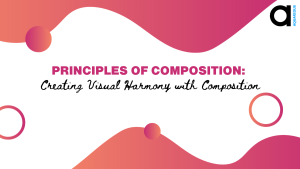Principles of Composition: Creating Visual Harmony with Composition

In the realm of web design, aesthetics play a pivotal role in capturing the attention of visitors and conveying the intended message effectively. One of the fundamental aspects of creating visually appealing websites is mastering the principles of composition. These principles serve as a blueprint for arranging elements on a page, allowing designers to achieve balance, harmony, and emphasis. In this article, we will delve into the key principles that underpin successful composition in web design, along with three essential laws that guide effective design.
Balance
Balance is the cornerstone of any well-composed web page. Achieving equilibrium in design involves distributing elements in a way that ensures no single component overwhelms the others. There are two main types of balance: symmetrical and asymmetrical. Symmetrical balance involves mirroring elements on either side of a central axis, creating a sense of stability and order. Asymmetrical balance, on the other hand, relies on visual weight to achieve balance, often incorporating contrasting elements for a dynamic and engaging layout.
Emphasis
Emphasis directs the viewer’s attention to the focal point of the design. It is crucial to identify the primary message or element that you want to highlight and employ visual cues such as size, colour, and contrast to draw attention to it. By strategically placing emphasis, web designers can guide users’ eyes towards the most important content or call-to-action, ensuring a clear and intuitive user experience.
Contrast
Contrast is a powerful tool that enables designers to create visual interest and highlight specific elements. This can be achieved through variations in colour, size, shape, or texture. Utilising high contrast between text and background, for instance, ensures readability and accessibility. Additionally, employing contrasting elements can establish hierarchy and visual flow, enhancing the overall user experience.
Repetition
Repetition instils consistency and coherence in a web design. By reusing certain elements, such as colours, fonts, or shapes, throughout a website, designers establish a visual identity that strengthens brand recognition. Consistent repetition fosters a sense of unity and professionalism, making the overall user experience more cohesive and memorable.
Proportion and Scale
Proportion and scale refer to the relative sizes of elements in a composition. These principles help establish hierarchy and create visual interest. By varying the size of elements, designers can guide the viewer’s gaze and emphasise specific content. It’s important to strike a balance between different scales to avoid overwhelming or underwhelming the audience.
Three Laws of Designing:
Hick’s Law:
Hick’s Law, also known as Hick-Hyman Law, is a principle in the field of design and psychology that suggests that the time it takes for a person to make a decision increases with the number of options they have. This law was formulated by British psychologist William Edmund Hick and American psychologist Ray Hyman.
In practical terms, it means that when designing interfaces, products, or experiences, it’s important to consider the number of choices a user has to make. Too many options can lead to decision paralysis, where users may struggle to make a choice, leading to frustration and potentially abandonment of the task.
Designers often aim to simplify interfaces and streamline decision-making processes to enhance user experience. This can be achieved through techniques such as categorization, prioritization, and providing clear guidance to help users navigate and make choices effectively.
Fitt’s Law:
Fitts’ Law, devised by psychologist Paul Fitts, is a principle in interface design. It asserts that the time taken to reach a target on a screen is determined by its distance and size. This implies that larger and closer targets are quicker to select. Designers can apply this by making crucial elements larger, arranging frequently used items for easy access, and ensuring minimal cursor movement. It’s particularly relevant for touchscreens, enhancing accessibility for all users. Following Fitts’ Law aids in crafting efficient and user-friendly interfaces, ultimately improving the overall user experience.
Gestalt Principles:
The Gestalt Principles of design are a set of psychological principles that explain how humans perceive and organise visual information. These principles are essential in graphic design, helping designers create aesthetically pleasing and effective compositions. Here are some key Gestalt Principles:
- Closure: Our brains tend to complete incomplete shapes or forms, creating a whole image even if parts are missing.
- Proximity: Objects placed close to each other are perceived as a group or related elements.
- Similarity: Elements that share similar attributes like shape, size, colour, or texture are seen as belonging together.
- Continuity: We tend to see continuous, smooth lines and patterns rather than disjointed segments.
- Figure-Ground: We automatically separate objects into the main subject (figure) and the background.
- Symmetry and Order: We prefer balanced and harmonious compositions over chaotic or asymmetric arrangements.
- Common Fate: Elements that move in the same direction or share a common motion are perceived as related.
- Prägnanz (Good Continuation): We prefer simple and clear shapes or forms over complex, ambiguous ones.
By applying these principles, designers can create visuals that are visually appealing, easily comprehensible, and engage the viewer’s attention effectively. Understanding how these principles work can greatly enhance the impact and effectiveness of design projects.
Aquarious Technology: Elevating Web Design with Innovative Solutions
In the fast-evolving landscape of web design, staying ahead of the curve is paramount. Aquarious Technology, a trailblazing leader in the field, offers cutting-edge solutions to enhance your web design endeavours. With a diverse range of tools and resources, Aquarious Technology empowers designers to seamlessly integrate the principles of composition into their projects.
The company’s design team simplifies the process of achieving the above principles and laws in your web design. Through innovative features and advanced functionalities, designers can effortlessly implement these to create visually stunning and user-friendly websites.
Conclusion
Mastering the principles of composition and understanding the laws of designing is essential for creating visually compelling web designs that resonate with users. By incorporating balance, emphasis, contrast, repetition, proportion and scale, along with adhering to design laws, designers can craft harmonious layouts that captivate and engage audiences. With the innovative solutions offered by Aquarious Technology, the process of implementing these principles and laws becomes even more seamless and efficient. Elevate your web design projects with Aquarious Technology and unleash the full potential of your creative vision.
-
14
+Category
-
98
+Post
Top Categories
Popular Posts
- The Power of Prototyping in Software Development
- Version Control Best Practices for App Development
- Understanding Visual Hierarchy: A Guide to Effective Design
- Crafting Intuitive Navigation: A Guide to Seamless User Experience
- Choose Your Best Cloud Provider
- Making the Leap: Transitioning from Manual to Automated Software Testing
- Using GitHub- Advantages and Disadvantages
- E-commerce Product Photography on a Budget
- Tech Innovation in Developing Countries
- Smart Cities: How Technology is Shaping the Urban Landscape
- Principles of Composition: Creating Visual Harmony with Composition
- Exploring Cross-Platform App Development
- Why Regular Website Updates Matter
- Navigating Effective Facebook Audience Targeting
- Implementing Ads for Game Monetization
- Designing User-Centric Mental Health Apps: Enhancing Well-being in the Digital Age
- NFTs and Collectibles: Creating NFT App Solutions for Collectors and Enthusiasts
- Successful Implementation of Enterprise Apps
- Maximizing Business Impact with EQ
- Proven SMO Ads Optimization Tips (2023)






